Have you ever wondered what the best video monetization platforms might be for your webinars, streams, and other valuable videos?
YouTube and Twitch might be some of the better-known names in the current landscape, but they’re far from your only option for success.
While services like YouTube boast around a billion hours of video watched every day, they don’t give you the same services you need to really stand out online compared to other solutions like Uscreen, Thinkific, and Teachery.
The best video monetization platforms are designed to provide everything you need to transform your videos into money-making assets.
This could include features which allow you to drip your content out to customers over time, or tools which help you with editing your videos.
What are the Best Video Monetization Platforms?
Here are just some of the top video monetization platforms you can consider in 2023.
1. Thinkific
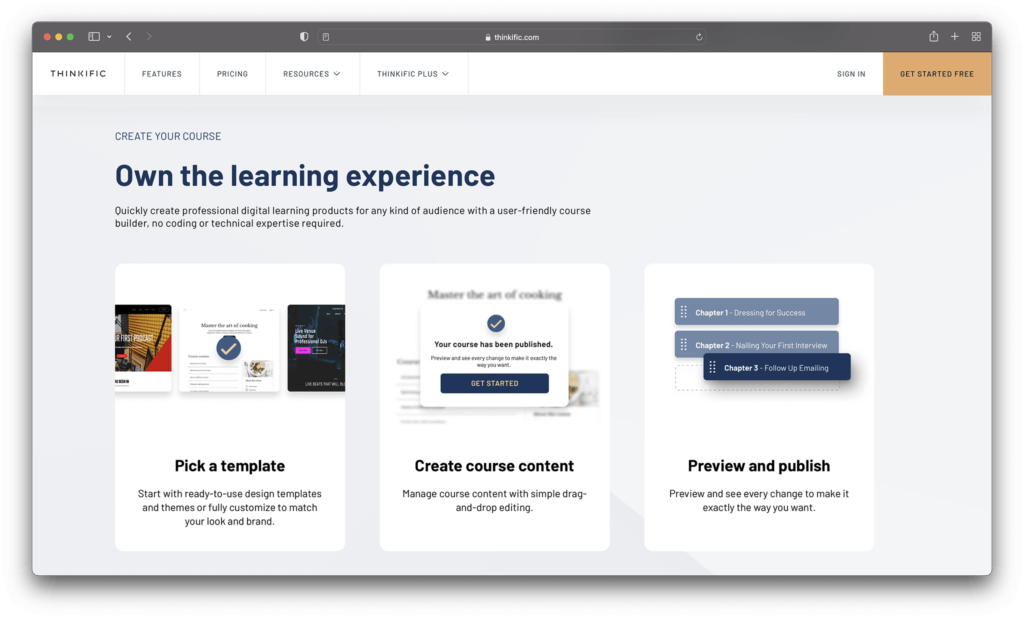
Designed to support would-be online educators, Thinkific is perfect if you want to monetize educational videos. The solution allows creators to sell a range of online courses and webinars, sold in the form of video lessons. It’s also one of the most popular online educational platforms around.
With more than 50,000 course creators using Thinkific today, you know you’re getting a service you can trust.
Within this ecosystem, you’ll be able to plan strategies for sharing your content, and drip specific videos out to your customers at the times most suitable for you.
Although you can’t “live stream” with all of Thinkific’s plans, you can easily create and customize a range of courses to suit your target audience, with access to live lessons on the premium plan.
There’s access to community creation, so you can bring your learners together in an environment where they can collaborate with their peers, and you can even deliver completion certificates.
Pricing
Thinkific has a range of pricing options depending on what you need. There’s a free version, which allows you to test-drive some of the more popular features of Thinkific with limited course creation features.
You do get access to ecommerce functionality, and a drag-and-drop course builder here, however. Some other plans include:
- Basic: $39 per month for unlimited courses, student and content, with access to scheduled content, one-to-one student email, basic academy courses, a custom domain, live chat support, and coupons and promotions.
- Pro: $79 per month for unlimited courses students, and content, and priority support, private and hidden courses, subscription pricing, and competition certificates. You also get live lessons here.
- Premier: $399 per month for all the features of “Pro” plus groups, onboarding packages, 15 group analysts, and unlimited communities.
Pros 👍
- Excellent for online educational experiences
- Fantastic range of flexible pricing options
- Drip and live lesson options
- Access to certification and exam options
- Community building
Cons 👎
- No simple live streaming
- Free version is somewhat basic
Further reading 📚
2. Teachery
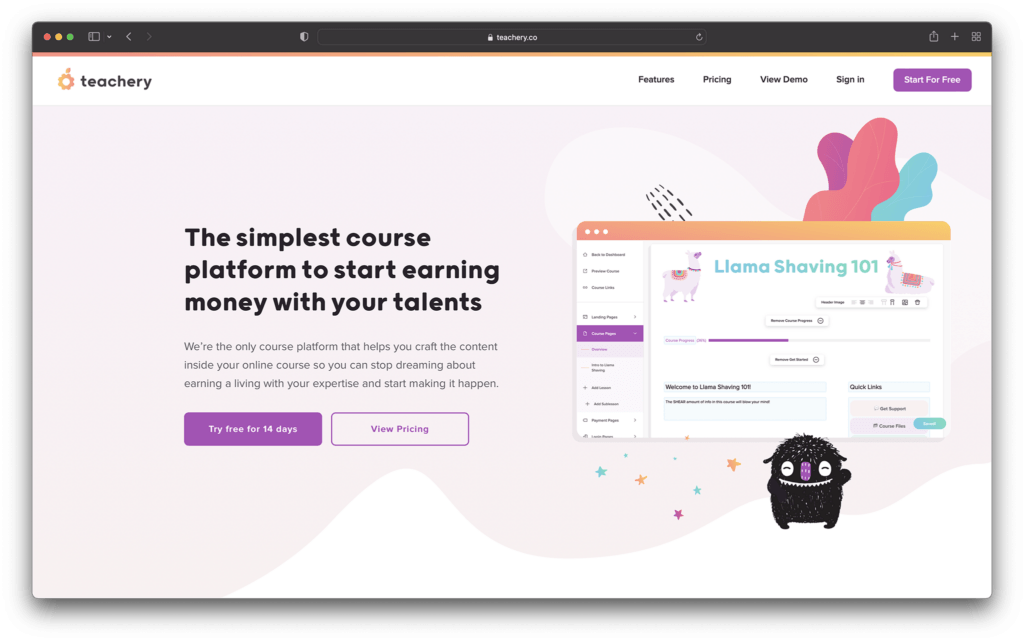
Similar to Thinkific, Teachery is less of a standard streaming platform and more of a site for building your educational brand.
With Teachery, you can build a portfolio of transactional video on demand for customers who want to learn from you. The solution allows you to drip premium content to your audience at a pace that suits you.
Outside of giving you an environment for video hosting, Teachery also allows you to interact with unlimited students, access an easy-to-use course editor, and set up recurring payment pages.
You’ll also have access to comprehensive customer analytics, custom domains, and email provider integrations, to nurture your leads.
If your business model involves actually helping your viewership learn something, Teachery has you covered. You can build an entire monetization strategy around your educational services. The streaming solution even offers a 2 week free trial.
Pricing
There are two options for how you can pay for Teachery. The first is to use the monthly plan at $49 per month to access all the features with zero fees.
The second option is to pay for the whole year at once, at a price of $470, which is a substantial saving.
Both options come with access to lesson drip scheduling, upsells and bundles, unlimited courses, unlimited students, unlimited landing and sales pages, an affiliate program to help with over-the-top money making options, and more.
Pros 👍
- Great for creating a unique user experience
- Good content management system for your lessons
- Deliver lessons in a range of formats
- Track viewership and student analytics
- Create a consistent source of income
Cons 👎
- Limited monetization options
- Not the best streaming service for live events
Further reading 📚
3. Patreon
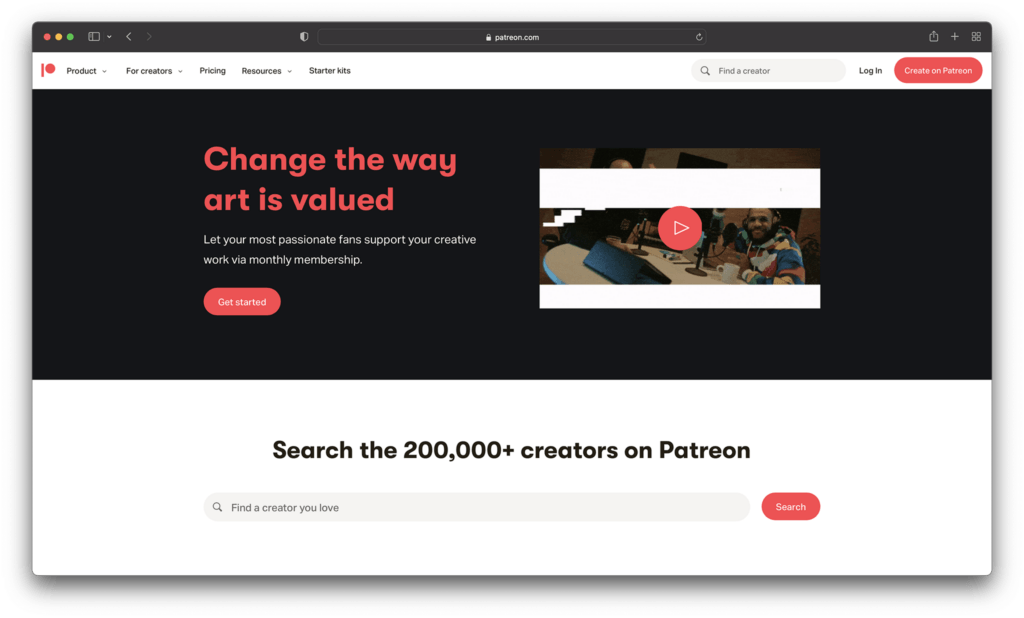
Probably one of the best-known platforms for video monetization, Patreon has changed the way creators distribute content and make money. The site allows fans to pay you a monthly membership fee in exchange for access to exclusive content.
Patreon benefits from being extremely easy-to-use and straightforward for beginners. There are more than 200,000 creators already active on the platform.
You can also access a range of bonus features depending on the kind of pricing you choose, such as a dedicated partner manager to help make your brand grow.
Patreon supports all kinds of content sharing and management outside of video. You can also use it to provide exclusive access to podcasts, music, visual art, written content, and educational videos or courses.
There are built-in communication tools for connecting with your target audience, hosted creator pages for you to build your brand, and various forms of on-site education.
Pricing
Patreon takes an interesting approach to pricing. While using the services is free, you will need to give a portion of your earnings back to the website. For instance, here are the basics of the three plans:
- Lite: 5% of your monthly earned income, a hosted creator page, and Patreon communication tools. Plus, workshops for learning.
- Pro: 8% of your monthly income for everything in “Lite” plus membership tiers, analytics and insights, creator-led workshops, unlimited app integrations, priority customer support, and special offers promo tools.
- Premium: 12% of your income for all the features of “Pro” along with a dedicated partner manager, merch for members, and team accounts
Pros 👍
- Excellent for building meaningful community connections
- Communications with your members included
- Merch creation is an option for extra income
- Excellent account support available
- You only pay when you get paid
Cons 👎
- Can be tricky to make an income at first
- Costs can get high depending on how much you earn
4. Wistia
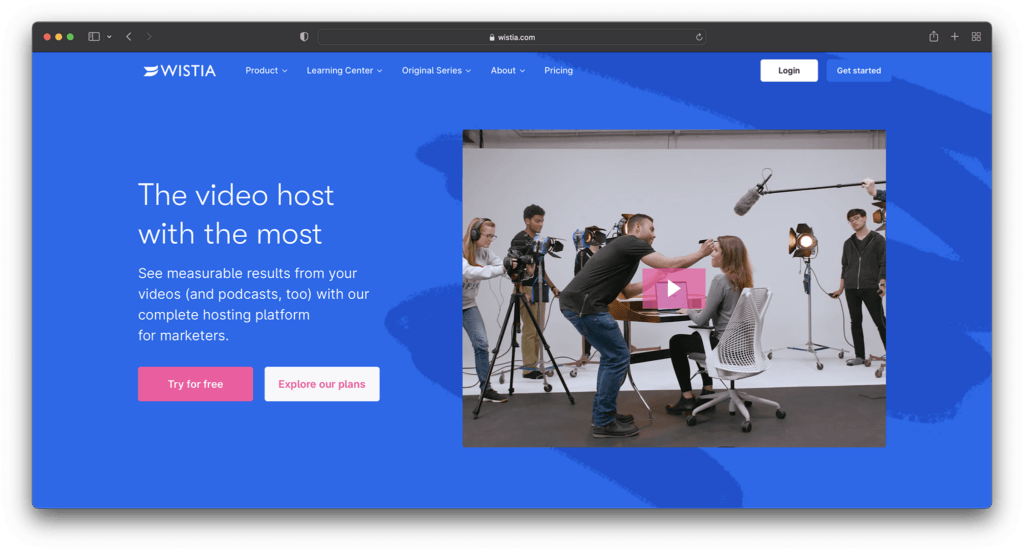
Wistia is a hosting site for video content, designed to help you deliver video on demand to a wide range of customers.
Like many of the top tools for online video, Wistia offers a range of ways for content creators to monetize their videos through VOD. You can add promotions to your videos to collect ad revenue or sell your video to consumers.
Wistia also offers the option to earn consistent income, through subscription videos on demand. This means you can use your video hosting channel to serve a community of customers with live streaming video, or pre-recorded high-quality content.
While there are page builder tools built into Wistia, they’re not quite as advanced as some of the more complete website building tools on the market.
On the plus side, there are a number of ways to engage your users with things like annotated links and gated content.
Pricing
There’s a free version of Wistia available with all the standard features for video and podcasts, and the option to embed 3 videos or podcast episodes anywhere. If you want to upgrade to more functionality, options include:
- Pro: $99 per month for 10 free video or podcast episodes, 1 channel to share via a Wistia link, and up to 250 channel subscribers.
- Advanced: A custom-priced solutions with multiple embedding options, 100 free video or podcast episodes, and your own branding on the video player.
Pros 👍
- Customizable video player for premium video experience
- Interactive calls to action
- Lots of monetization options for your video library
- Embed video player URLs in various sites
- Advanced video analytics
Cons 👎
- Limited video marketing options
- Can be expensive
Further reading 📚
5. Muvi
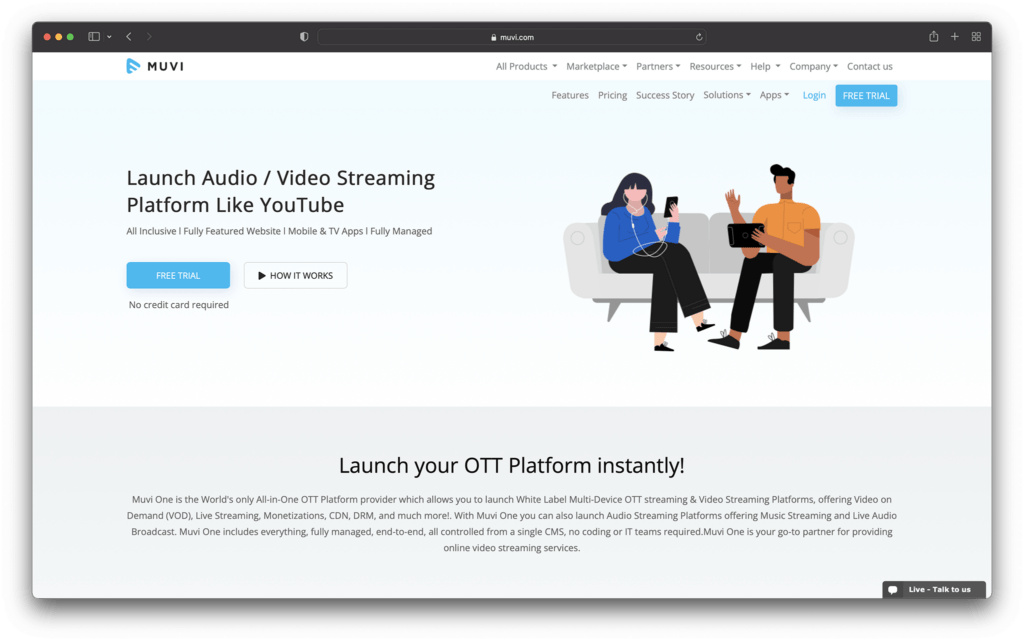
Muvi is an “OTT” platform provider, designed to support content creators in launching white-label multi-device streaming and video streaming platforms. Essentially, you can create a comprehensive OTT video channel, with multi-device video access, so customers can see your content anywhere.
With Muvi, you can showcase your videos on a smart TV, android, or Apple device. Leading companies like Sony and Nike already use the service.
Through Muvi, users can unlock live streaming, CDN, DRM, and video on demand (VOD) There’s also the option to set up audio streaming on demand if you want to create a service like Shopify.
For those who want to deliver live content immediately, Muvi also supports broadcasting, and you can use the OTT platform with a range of monetization methods to get the best revenue share. For instance, set up paywall content, offer rentals, or explore subscription video on demand with video ads.
Pricing
The Muvi service comes in a range of packages to suit different needs. The least expensive option is the “Standard” service for $399 per month, or you can save 15% by paying yearly.
This package comes with support for 2000 concurrent users, a shared hosting service, and 1TB a month of bandwidth.
There are a total of 5 packages, including:
- Professional: $1499 per month
- Enterprise: $3900 per month
- Ultimate: $8900 per month
- Black: Pricing via quote
The more you spend on the platform, the more you can expect to get in terms of storage, bandwidth, and support for concurrent users.
Pros 👍
- Excellent OTT streaming solution
- Range of monetization and pay-per-view options
- Audio or video streaming available
- Access to analytics and insights
- Fully-managed, end-to-end support managed from a CMS
Cons 👎
- Quite expensive for beginners
- Learning curve for some
6. Lightcast
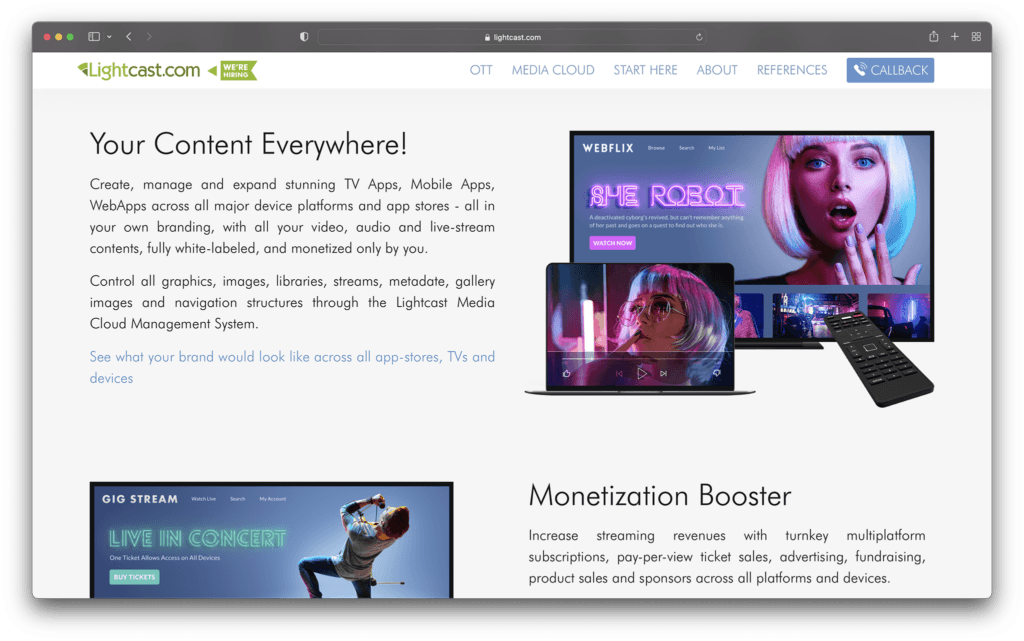
Advertised as “streaming on steroids”, Lightcast is a media cloud solution which allows business leaders to upload, manage, and publish various streams of video and audio anywhere.
You can create and manage video content across a range of major device platforms and app stores. Lightcast also allows you to add your own branding, with a fully white labelled service.
Part of what makes Lightcast so compelling to those who want a video monetization platform, is its monetization booster.
You can increase your streaming revenue with pay-per-view ticket sales, subscriptions, and fundraising options. There’s also the option to access sponsors and video ads across multiple devices and platforms.
On top of all this, users also get access to a comprehensive content management system, where they can add watermarks to their video content, control their uploads, and even implement new advertising campaigns, based on changing needs.
Pricing
Lightcast is a little different to other SVOD, and online streaming platforms. The company only offers pricing on a per-quote basis.
This means you can rest assured you’re going to get a pricing structure customized to your needs, but it’s difficult to predict how much you’re going to spend in advance.
Pros 👍
- Wide range of monetization models to choose from
- TVOD, AVOD, and other streaming options
- Access sponsorships and advertising partnerships
- Convenient backend management for content
- White labelled branding
Cons 👎
- No transparent pricing
- Can be complex for beginners
7. Cleeng
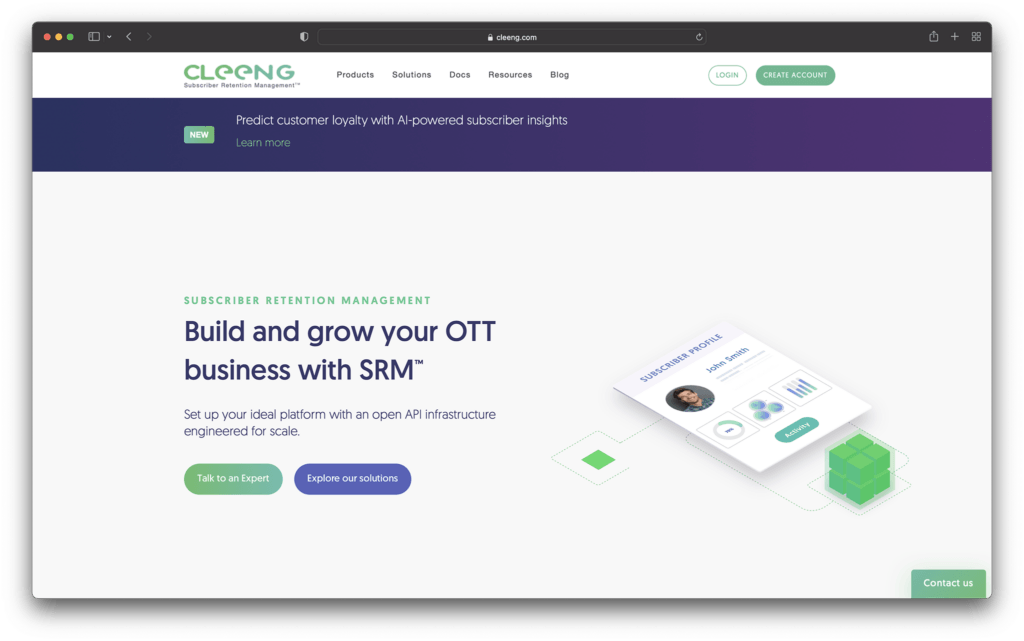
Focused specifically on subscriber-based video monetization, Cleeng is an all-in-one solution for managing subscriber information, and connecting with clients.
The solution provides everything from predictive analytics, to help you understand your customer’s preferences better, to AI-powered overviews of your streaming data.
With all of your subscriber analytics located in the same place, it’s easier to predict and prevent churn, so you can improve your long-term revenue. There’s also access to a range of “integrateable” solutions, such as tax and billing management.
A smart API infrastructure ensures businesses with the right developer knowledge can easily enhance their platforms in no time, seamlessly linking in new forms of technology, from billing tools to identity management. You can also access live “pay per view” services for events.
Pricing
Cleeng is another solution in the video monetization world without a lot of information to offer about pricing structure. There aren’t any transparent costs on the website itself, so you’ll have to contact the team and discuss your needs with one of the agents to get a quote.
The exact amount you can expect to pay will depend on what kind of features you want, such as real-time event streaming, or machine learning analytics.
Pros 👍
- Artificial intelligence and machine learning to boost subscriptions
- Excellent insights for your video on demand platform
- Support for live events
- Predictive analytics
- Customizable feature packages
Cons 👎
- No transparent pricing
- Can be complex for beginners
8. VlogBox
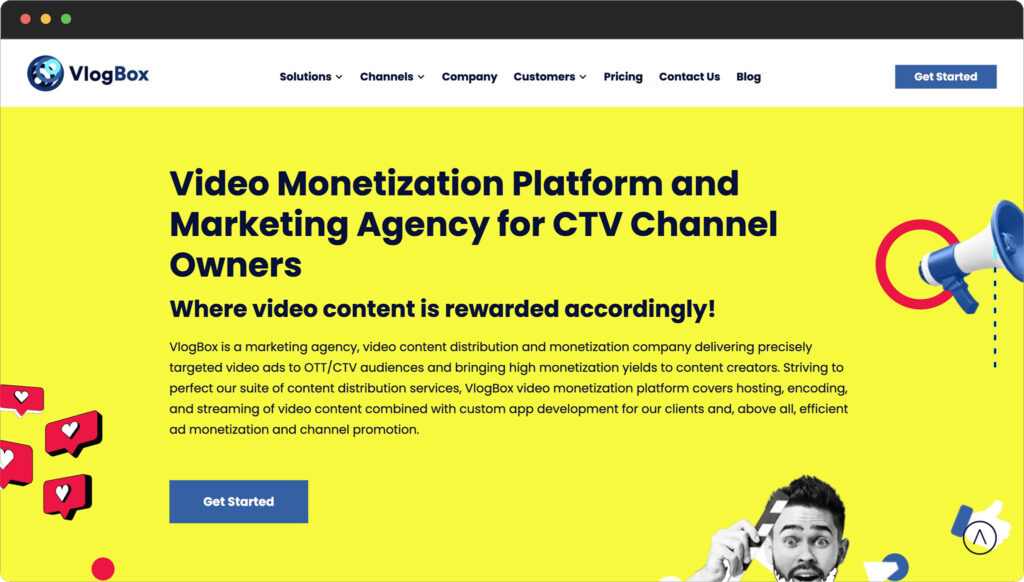
VlogBox is a leading video monetization platform that enables anyone to create their own video channel. You can stream your content via significant providers such as Roku, Amazon, Android TV, and Apple TV.
You tell VlogBox about your brand, and they will develop a fully-hosted app explicitly designed for connected TV (CTV) viewing.
To make money from your videos, you need to create a VlogBox account, pick your preferred publishing platforms, choose the template that looks the best fit for your future channel and then upload your videos. Once your channel has grown big enough, you can start monetizing it with VlogBox.
VlogBox provides a wide range of services to help you grow your audiences and monetize your video content both with SVOD and AVOD models. . VlogBox has a full-cycle CTV advertising agency that offers channel owners support in their channel promotion and audience extension to maximize their monetization potential.
You can monetize content by charging viewers a monthly subscription fee or utilize on-demand advertising, i.e., where you play ads before, during, and after your content.
Customers with large audiences can also enter a revenue-sharing model with VlogBox.
You can track your revenue via the VlogBox dashboard. On top of that, VlogBox provides analytics to help you understand the success of your campaigns, audience demographics, and return on ad spending (ROAS).
It even includes detailed reporting on each area and visualization through graphs and charts to help you understand your data.
Pricing
VlogBox doesn't have a free plan. Pricing starts at $399 a month but requires a $1,000 upfront payment for initial app development. All plans include ad monetization, a video content management system, and access to a dedicated support team.
However, to unlock analytics, live streaming, and multi-platform publishing, you need to be on the Pro plan or above, starting at $699 per month.
The Business Plan for $1,099 per month provides you with your own CDN and hosting server, as well as your own branded website. You’ll also receive priority support and PR and marketing support.
Pros 👍
- You benefit from your own fully hosted video app.
- You can access ongoing customer support.
- VlogBox’s advertising services seem impressive.
- Multi-channel publishing is possible, which works wonders for extending your reach.
- Access to advanced analytics (on the Pro plan and upwards)
Cons 👎
- A free plan isn’t available.
- It requires a one-off initial investment of $1,000, which might be untenable for small businesses working with tight budgets.
- High cost for app maintenance
- Each plan imposes storage limitations, so if you surpass the 300GB included in the Starter plan, you’ll have to upgrade to themore expensive Pro Plan.
- You can’t let your viewers rent or buy videos.
9. Uscreen
Often advertised as the number one platform for video monetization, Uscreen is a state-of-the-art platform for growing your streaming or video business.
You can upload and organize your content in bulk, adding custom filters and labelling different videos. There’s also the option to stream content directly on demand to a wide audience.
Uscreen enables the creation of live streaming events for your customers, as well as in-depth analytics, so you can see which of your campaigns are driving the best results.
There are a number of monetization options, such as one-time purchases and subscriptions, credit cards, and PayPal. You’ll also be able to create streaming experiences on a range of apps.
Uscreen makes it quick and easy for video creators to find their own earning opportunities online. You can launch your streaming environment using a range of video website themes and templates and access a host of built-in marketing tools for promotion.
There’s even expert guidance available from the Uscreen team for beginners.
Pricing
There are various packages available from Uscreen, and you’ll save a little extra cash if you’re willing to pay annually (20% in total). The options include:
- Basic: $79 per month with $0.50 per subscriber, per month added on: 50 hours of video storage, 1 admin, 1 onboarding session and email support. You also get a custom website, flexible pricing, support for credit cards and paypal, business and customer analytics, and marketing tools.
- Growth: $159 per month with $0.50 added per subscriber, per month for all the features of Basic, plus 10 admin users, 150 hours of video, 3 onboarding sessions, and chat support. You also get ecommerce integrations, Zapier, and third-party integrations
- Plus: Custom pricing: Everything in Growth plus TV streaming apps, live streaming analytics, chat, and white-labelled branding, as well as dedicated account managers.
Pros 👍
- Excellent range of video streaming options
- Lots of payment options available
- Expert guidance and support
- Lots of video website themes and templates
- In-depth analytics
Cons 👎
- Can get quite expensive very quickly
- No course creation options
Further reading 📚
Choosing your Video Monetization Platform
There’s no one-size-fits-all strategy when it comes to choosing the right tools for video monetization. There are tons of great ways to showcase your content online today, from Amazon Prime, to Vimeo, social media streaming, Netflix, and Hulu.
The right solution for you will depend on exactly what kind of content you want to create and share. For those in the educational environment, tools like Thinkific and Teachery will make a lot of sense, with built-in features to help you connect with students.
Alternatively, if you’re looking for live streaming and events, you might choose something like Muvi.
Don’t forget, many of these tools do offer free demos and trials, so it’s definitely worth testing the technology if you can before you make a commitment.


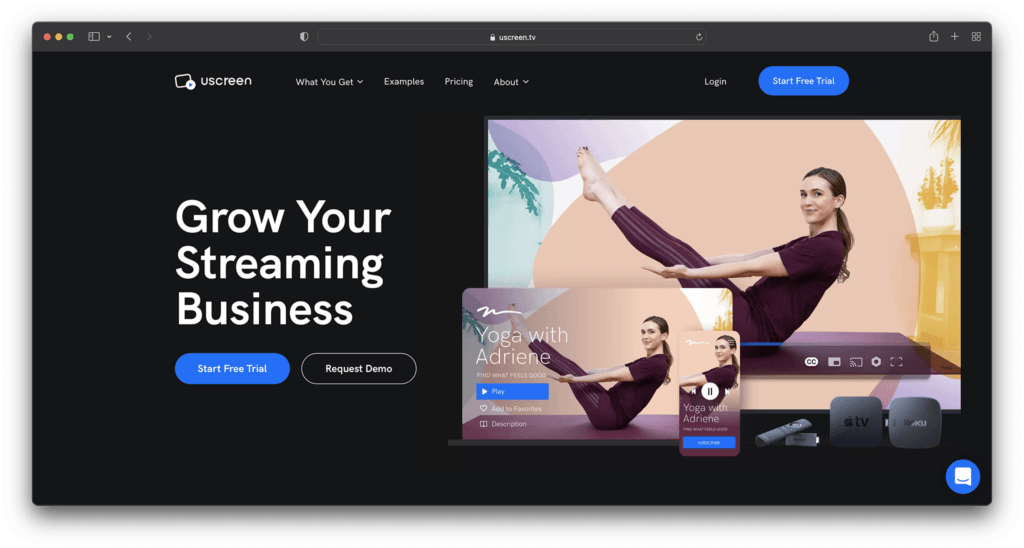


Comments 0 Responses